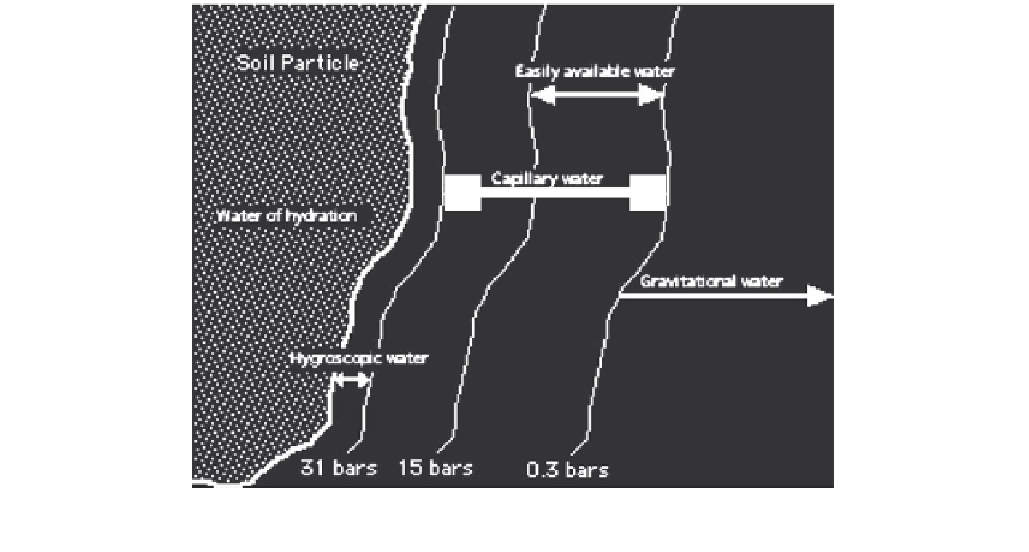Agriculture Reference
In-Depth Information
example, in a clay soil with 15% moisture, whereas in a
sandy soil, moisture may drop as low as 6% before the
crop will wilt.
Because water is held more tightly in some kinds of
soil compared to others, another measure besides just per-
cent moisture content is needed, which better reflects the
attractive force between soil particles and moisture. This
measure is achieved by expressing soil moisture in energy
terms. The force of attraction of water molecules to soil
particles, the soil water potential, is expressed as bars of
suction, where one bar is equivalent to standard atmo-
spheric pressure at sea level (760 mm Hg or 1020 cm of
water). This method provides a means of measuring the
availability of water in the soil solution and takes into
account the varying forces of attraction determined by soil
particle size and organic matter content.
A number of special terms are used to describe water
moisture content and availability in terms of attractive
forces. These are defined below and illustrated in
Figure 9.2.
31 bars of suction. After soil has been oven
dried, the remaining nonchemically bound
water is hygroscopic water.
•
Water of hydration
is the water that is chemi-
cally bound with the soil particles.
•
Easily available water
is the portion of the
water in the soil that is readily absorbed by plant
roots — usually capillary water between 0.3
and 15 bars of suction.
•
Field capacity
is the moisture left in the soil
after the downward pull of gravity has drained
the macropores of gravitational water, leaving
the micropores filled with capillary water held
with at least 0.3 bars of suction to soil particles.
•
Permanent wilting point
is the moisture content
of the soil at which a plant wilts and does not
recover even when placed in a dark, humid
environment. Permanent wilting point usually
occurs when all the capillary water held at less
than 15 bars of suction has been removed from
the soil.
•
Gravitational water
is water that moves into,
through, and out of the soil under the influence
of gravity alone. Immediately following rain or
irrigation, this water begins to move downward
into the soil, occupying all macropore spaces.
Since every soil is a different mixture of particle sizes
and is variable in organic matter content, and because
these characteristics determine water retention ability, it
is important to determine the soil type as a part of deve-
loping a water management plan. In most soils, optimum
growth takes place when soil moisture content is kept just
below field capacity. It is clear that the moisture needed
for optimum growth does not extend over the complete
range of soil moisture content.
•
Capillary water
is the water that fills the
micropores of the soil and is held to particles
with a force between 0.3 and 31 bars of suction.
•
Hygroscopic water
is the water held most
tightly to soil particles, usually with more than
Soil Particle
Easily available water
Capillary water
Water of hydration
Gravitational water
Hygroscopic water
31 bars
15 bars
0.3 bars
FIGURE 9.2
Soil moisture in relation to force of attraction to soil particles.
Permanent wilting point is reached when easily
available water has been depleted. Field capacity is the amount of water remaining after gravitational water has drained away.














Search WWH ::

Custom Search